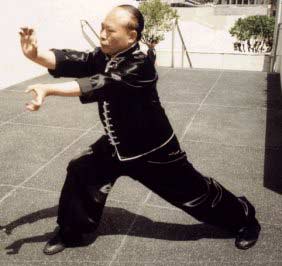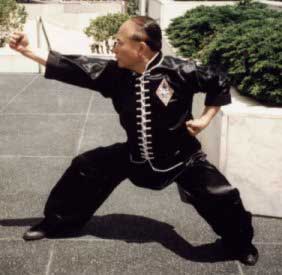819A Sacramento Street
San Francisco, CA 94108
(415) 781 - 4682
Monday, Tuesday, Thursday
5:30 p.m. to 8:00 p.m.
Saturday and Sunday (mornings)
9:30 a.m. to 12:00 noon
HUNG GAR HAND FORMS

Hung-Gar is one of the original Kung Fu styles directly from the Shaolin Temple. It is also known as the Tiger-Crane style because these two animals symbolize the unique characteristics of this style: the tiger, representing fierceness and powerful character, perfectly complements the crane, representing agility and swift movement. Hung-Gar has strong versatile hand techniques and powerful effective kicks that are applicable to close-range as well as long-range situations. Hung-Gar also has a variety of traditional weapons whose practice develops strength and coordination. The beginning and intermediate levels of training in Hung-Gar provide the student with an excellent physical condition, enabling the individual to continue into the advanced level, which is the internal phase of training in the style.
 | (Conquering the Tiger Form) (Tiger Crane Form) (Ten Form Fist) (Iron Thread Form) |
The foundation of all other Hung Gar forms. The transliteration of Kung in this specific instance refers to the Chinese character I and is therefore sometimes interpreted as the "I Shaped Subduing the Tiger Form ". There are many other translations: "Cross Tiger Fist Form" and "Conquering the Tiger Form". This is the oldest form in Hung Gar Kung Fu believed to have been developed by Hung Hei Goon after his intense training with his Sifu Abbot Gee Sing. This form teaches the practitioner the basic stances and builds his foundation through emphasis on the horse stance as well as developing and enhancing one's breathing capacity. This is the longest form in Hung Gar and is one of the hardest. It is while the student is learning this form that his character, persistence and determination to learn the system are assessed. His patience is also put to the test time and time again with this form.
This is the most famous and popular of the Hung Gar forms and is said to have been developed by Wong Fei Hung. This form stresses the cultivation of the Tiger and Crane as well as a balance between the two complementing each other in the form. While the Tiger is utilized for teaching one to refine his physical entity (power), dynamic tension breathing skills and courage. The Crane develops whipping power, evasive tactics, waist movement, and calmness of the spirit and balance. The Tiger form of training provides the hard or external methods of Hung Gar while the Crane form provides the soft or internal balance between the two.
Sup Ying Kuen (Ten Form Fist)


This is an advanced form featuring the five traditional animals of the Shaolin Temple, the Dragon, Snake, Leopard, Tiger and the Crane. It also contains the five elements (wood, water, metal, earth & fire) found in Chinese philosophy Each of the animals teaches the practitioner an important lesson. The Dragon teaches internal training in Hung Gar. It is the first animal represented in the form. The Dragon is a spiritual and supernatural creature and transcends from the easily understood real world. The power of the Dragons strength can appear and disappear at will. Its domain is therefore internal power and spirit. The Snake trains the fingers and is for striking the vital points on an opponent's body. It is utilized in the training and manipulation of Chi (Vital Energy). It teaches pinpoint hitting of vital areas. The Practitioner focuses his Chi all the way up to his fingertips in order to deliver and generate power correctly. The Tiger is designed to strengthen the constitution and has a fierce spirit. This animal emits ferocity, courage and strength since it is the strongest of the animals. Dynamic tension, vigorous and strong hand techniques in the form of Tiger claws is what characterizes this animal. The Leopard is the embodiment of speed and power. It has swift penetrating attacks. The Leopard fist strikes always involve more than one strike and always at extremely quick speeds. The Crane stresses balance, quick foot movements, pecking, hooking and deflecting movements. It is a lively animal whose essence can be seen in its beak attacks and pecking motion.
The Metal element involves a strong slow stretching power. The entire arm is used as a solid unit. The elbows are always bent slightly in this movement, as there is less susceptibility to the arms being broken. The Wood element is a simultaneous block and strike and is the shortest arm movements in Hung Gar. This element teaches long and short arm sequences. The Water element are strikes which are of a constant nature. A series of battering blows similar to the pounding of ocean waves upon the shores. It is the swinging motion of the practitioner's arms which are the source of the Water element's power. The Fire element is characterized by a straight punch. Its more common name is the Sun Punch because the fist forms the character Sun in Chinese characters. The sun is a fiery mass. The Earth element is the last of the elements and closes the form. It develops a strong foundation. (Boxing is rooted in the feet, developed in the legs, directed by the waist and is expressed through the hands). Since the practitioner's foundation is so strong, he is capable of delivering some very destructive blows.
The Dragon, Snake, Tiger, Leopard and Crane are said to give the practitioner five ways to manipulate and use his strength while the Wood, Fire, Gold, Water and Earth elements are said to give him five ways to generate and transform the power in each of these forms.
Tid Sin Kuen (Iron Thread Form)The Metal element involves a strong slow stretching power. The entire arm is used as a solid unit. The elbows are always bent slightly in this movement, as there is less susceptibility to the arms being broken. The Wood element is a simultaneous block and strike and is the shortest arm movements in Hung Gar. This element teaches long and short arm sequences. The Water element are strikes which are of a constant nature. A series of battering blows similar to the pounding of ocean waves upon the shores. It is the swinging motion of the practitioner's arms which are the source of the Water element's power. The Fire element is characterized by a straight punch. Its more common name is the Sun Punch because the fist forms the character Sun in Chinese characters. The sun is a fiery mass. The Earth element is the last of the elements and closes the form. It develops a strong foundation. (Boxing is rooted in the feet, developed in the legs, directed by the waist and is expressed through the hands). Since the practitioner's foundation is so strong, he is capable of delivering some very destructive blows.
The Dragon, Snake, Tiger, Leopard and Crane are said to give the practitioner five ways to manipulate and use his strength while the Wood, Fire, Gold, Water and Earth elements are said to give him five ways to generate and transform the power in each of these forms.

This form was created by Tid Ku Sarm, one of the best martial artists in the history of China. He was one of the famous Ten Tigers of Kwangtung. Through the years he passed his knowledge of the set down to one of his students, Wang Fei Hung. This form is the highest set taught in the Hung Gar system. It takes the practitioner into the realm of internal Kung Fu training, which is the ultimate goal in Chinese martial arts. Tid Sin's limited footwork is based solely upon the movements and spirit of the Dragon coupled with vibrating sounds and various intonations of breath control with twisting movements which stimulate the internal organs. Each emotion (Happiness, Anger, Sadness, Sorrow and Fear) is said to be translated into a breathing tone producing different vibrations, which affect different organs. From the breathing sounds comes a strong type of power, which is emitted from within the practitioner. There are twelve types of training methods contained in this form. They are Hard, Soft, Lineal, Isometric Contractions, Linking, Dividing, Supporting, Stationary, Circular Transition, Determination, Exactness and Immobilization. These twelve types of training are designed to control and improve the internal functions of the organs. It is a dynamic tension exercise used to increase the flow of Chi throughout the body. It is an efficient means of body building and stamina development.
Tai Chi Tai Chi originated hundreds of years ago from the fusion martial arts and Taoism. Today, Tai Chi is generally practiced for its health benefits and enjoys great popularity. Yet it remains a potent martial art. The flowing circular movements in the Tai Chi forms are naturally relaxing and therapeutic. These very same moves can be applied in self-defense to ward off and deflect an opponent's strikes. At a more advanced level, push hands practice further enhances the skill of sensing and neutralizing an opponent's energy and force.
I Chuan
The I-Chuan Standing Meditation practice is distilled from the essence of a number of martial art styles, among them Hsing I, Tai Chi, Pa Kua, and Shaolin. It also derives its methods from Buddhist and Taoist Chi Kung. The founder, Wang Hsiang-chai, was a highly respected master of legendary skill who spent many years researching and practicing martial arts during the early part of the twentieth century. Standing Meditation emphasizes training of the mind as well as the body. Its practice leads to heightened awareness and sensitivity, and develops a strong framework for health and self-defense.
Push hand
Push Hands is a two-person exercise in which each participant tries to throw the other off balance while actively sensing and neutralizing the opponent's attempts. It can be practiced in a prescribed pattern of movements or freestyle, with single or double hands and fixed or moving steps. Successful Push Hands practice requires the participants to be relaxed and aware, to maneuver in circular movements, and to maintain contact and flow. Push Hands exercise is complementary to solo form practice in styles such as Tai Chi and I-Chuan Standing Meditation.
Pa kua
 | Pa Kua is a style of martial art that has been strongly influenced by the philosophy of I Ching (Book of Changes) and has been around for several centuries. The characteristics of Pa Kua are superb footwork, twisty circular and springy linear movements. Its fundamentals include extensive circle walking practice to develop quickness and mobility in all directions. Hand techniques, with heavy use of the palms, are practiced together with intricate footwork in repeated sequences of forms to achieve a high level of proficiency in attack and defense. |












No comments:
Post a Comment